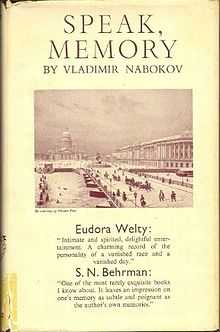Speak, Memory
Speak, Memory is an autobiographical memoir by writer Vladimir Nabokov.
 First UK edition | |
| Author | Vladimir Nabokov |
|---|---|
| Language | English |
| Publisher | Victor Gollancz (1951 UK) |
Scope
| “ | The cradle rocks above an abyss, and common sense tells us that our existence is but a brief crack of light between two eternities of darkness. | ” |
| —Speak, Memory, as quoted in Time Magazine cover article, 30 March 1999[1] | ||
The book is dedicated to his wife, Vera, and covers his life from 1903 until his emigration to America in 1940. The first twelve chapters describe Nabokov's remembrance of his youth in an aristocratic family living in pre-revolutionary Saint Petersburg and at their country estate Vyra, near Siverskaya. The three remaining chapters recall his years at Cambridge and as part of the Russian émigré community in Berlin and Paris.
Nabokov published "Mademoiselle O", which became Chapter Five of the book, in French in 1936, and in English in the Atlantic Monthly in 1943, without indicating that it was non-fiction. Subsequent pieces of the autobiography were published as individual or collected stories, and each chapter can stand on its own. Andrew Field observed that while Nabokov evoked the past through “puppets of memory” (in the characterizations of his educators, Colette, or Tamara, for example), his intimate family life with Véra and Dmitri remained "untouched".[2] Field indicated that the chapter on butterflies is an interesting example how the author deploys the fictional with the factual. It recounts, for example, how his first butterfly escapes at Vyra, in Russia, and is "overtaken and captured" forty years later on a butterfly hunt in Colorado.
Various publications
Nabokov writes in the text that he was dissuaded from titling the book Speak, Mnemosyne by his publisher, who feared that readers would not buy a "book whose title they could not pronounce". It was first published in a single volume in 1951 as Speak, Memory in the United Kingdom and as Conclusive Evidence in the United States. The Russian version was published in 1954 and called Drugie berega (Other Shores). An extended edition including several photographs was published in 1966 as Speak, Memory: An Autobiography Revisited.
There are variations between the individually published chapters, the two English versions, and the Russian version. Nabokov, having lost his belongings in 1917, wrote from memory, and explains that certain reported details needed corrections; thus the individual chapters as published in magazines and the book versions differ. Also, the memoirs were adjusted to either the English- or Russian- speaking audience. It has been proposed that the ever-shifting text of his autobiography suggests that "reality" cannot be "possessed" by the reader, the "esteemed visitor", but only by Nabokov himself.[2]
Nabokov had planned a sequel under the title Speak on, Memory or Speak, America. He wrote, however, a fictional autobiographic memoir of a double persona, Look at the Harlequins!, apparently being upset by a real biography published by Andrew Field.
Chapters
The chapters were individually published as follows—in the New Yorker, unless otherwise indicated:
- "Mademoiselle O" (Chapter Five), published first in French in Mesures in 1936, portrays his French-speaking Swiss governess, Mademoiselle Cécile Miauton, who arrived in the winter of 1906. In English, it was first published in the Atlantic Monthly in 1943, and included in the Nine Stories collection (1947) as well as in Nabokov's Dozen (1958) and the posthumous The Stories of Vladimir Nabokov.
- "Portrait of My Uncle" (Chapter Three), 1948, gives an account of his ancestors as well as his uncle "Ruka". Nabokov describes that in 1916 he inherited "what would amount nowadays to a couple of million dollars" and the estate Rozhdestveno, next to Vyra, from his uncle, but lost it all in the revolution.
- "My English Education" (Chapter Four), 1948, presents the houses at Vyra and St. Petersburg and some of his educators.
- "Butterflies" (Chapter Six), 1948, introduces a lifelong passion of Nabokov's.
- "Colette" (Chapter Seven), 1948, remembers a 1909 family vacation at Biarritz where he met a nine-year-old girl whose real name was Claude Deprès. As "First Love" the story is also included in Nabokov's Dozen.
- "My Russian Education" (Chapter Nine), 1948, depicts his father.
- "Curtain-Raiser" (Chapter Ten), 1949, describes the end of boyhood.
- "Portrait of My Mother" (Chapter Two), 1949, also discusses his synesthesia.
- "Tamara" (Chapter Twelve), 1949, describes a love affair that took place when he was seventeen, she sixteen. Her real name was Valentina Shulgina.[2]
- "First Poem" (Chapter Eleven), 1949, published in Partisan Review, analyzes Nabokov's first attempt at poetry.
- "Lantern Slides" (Chapter Eight), 1950, recalls various educators and their methods.
- "Perfect Past" (Chapter One), 1950, contains early childhood memories including the Russo-Japanese war.
- "Gardens and Parks" (Chapter Fifteen), 1950, is a recollection of their journey directed more personally to Véra.
- "Lodgings in Trinity Lane" (Chapter Thirteen), 1951, published in Harper's Magazine, describes his time at Cambridge and talks about his brothers.
- "Exile" (Chapter Fourteen), 1951, published in Partisan Review, relates his life as an émigré and includes a chess problem.
References
- ↑ "Prospero's Progress". www.time.com Time Magazine. 1999-03-30. Retrieved 2009-04-21.
- ↑ 2.0 2.1 2.2 Field, Andrew. VN, The Life and Art of Vladimir Nabokov. Crown Publishers, Inc., New York (1977), ISBN 0-517-56113-1.
See also
| ||||||||||||||||||||||||||||||||||||||